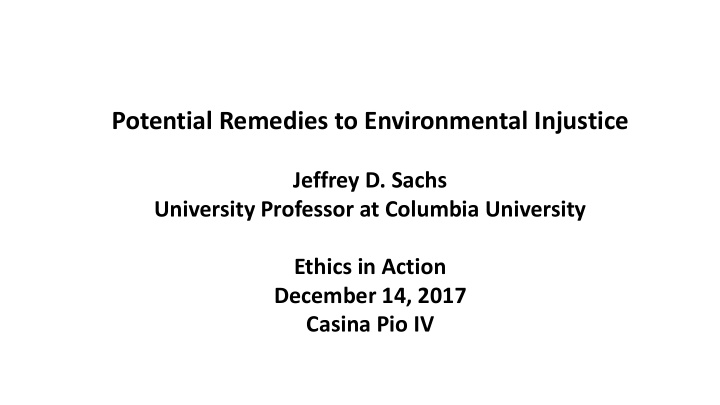



Potential Remedies to Environmental Injustice Jeffrey D. Sachs University Professor at Columbia University Ethics in Action December 14, 2017 Casina Pio IV
Massive and growing losses from environmental harms, such as $360B in damages from three Caribbean hurricanes this summer (Harvey, Irma, Maria). Who is responsible? Who s hould pay for “Losses and Damages”?
Environmental Justice: A Starting Point Each individual has a right to a safe environment Each individual is entitled to a remedy when the right to a safe environment is violated
Complete Justice versus Partial Justice Environmental Justice cannot solve all problems of justice, but should mainly address the wrongs committed to environmental rights
Environmental Justice: Some Complexities Environmental rights involving public goods such as the safety of the air, water, and climate, and the conservation of biodiversity raise complexities regarding rights, responsibilities, and remedies (multiple actors, multiple interests, complex causation and attribution) What are the rights of future generations and other species? What are the appropriate remedies to environmental harms? Restitution, compensation, mitigation, others?
Remedies Since environmental damages tend to be ongoing harms, a remedy typically involves a combination of: (1) Compensation for losses and damages (2) A duty of the wrongdoer to protect the environment in the future, including (potentially) clean-up activities and mitigation
Attribution: Joint and Several, and Probabilistic In some cases, the losses and damages apply to a discrete event with an identifiable set of causes and actors, such as the BP Gulf Oil Spill; In cases of climate change, however, the losses and damages are due to multiple actors, multiple factors, and attribution to climate change is only probabilistic and shared among a large number of actors.
Thus, in the case of human-induced climate change, the conceptual problems of applying “just” solutions include: (1) The problem of joint and several responsibility for environmental harms, including past and current actions (2) The problem of attribution of damages to climate change (3) The problem of accountability : who should be held accountability for fossil-fuel emissions? Consumers, Producers of final goods and services, Producers of fossil fuels, Government regulators, others? (4) The problem of multiple damages: complex effects of AGW (5) The problem of remedies : compensation, mitigation, restoration, and to whom? (6) The problem of future generations and other species
The Advances of Attribution Science
HURRICANE HARVEY, 2017 EURO-MED HEAT WAVE, 2017 AUSTRALIA EXTREME HEAT, 2017 EUROPEAN RAINSTORMS, 2016 GREAT BARRIER REEF BLEECHING, 2016 LOUISIANA DOWNPOURS, 2016 World Weather Attribution: https://wwa.climatecentral.org/
Relative Risk = Probability of Event with AGW Probability of Event without AGW Attributable Risk = (RR-1)/RR Liability can be assessed as Damages x AR
Accounting For Emissions
Historical Responsibility By Major Producer
CORPORATE CLIMATE MALFEASANCE
23 August 2017
Other Forms of Public Accountability
Some Potential Remedies: Carbon taxes directed at Losses and Damages Class Action Suits against Governments and Corporations Corporate Shareholder Responsibility Actions Corporate Accountability for Public Awareness
Text of Court-Ordered Corrective Statements: United States v. Philip Morris USA Inc. (November 2017) Adverse Health Effects of Smoking. Smoking kills, on average, 1,200 Americans. Every day. More people die every year from smoking than from murder, AIDS, suicide, drugs, car crashes, and alcohol, combined. Smoking causes heart disease, emphysema, acute myeloid leukemia, and cancer of the mouth, esophagus, larynx, lung, stomach, kidney, bladder, and pancreas. Smoking also causes reduced fertility, low birth weight in newborns, and cancer of the cervix. Addictiveness of Smoking and Nicotine . Smoking is highly addictive. Nicotine is the addictive drug in tobacco. Cigarette companies intentionally designed cigarettes with enough nicotine to create and sustain addiction. It’s not easy to quit. When you smoke, the nicotine actually changes the brain – that’s why quitting is so hard. Lack of Significant Health Benefit from Smoking “Low Tar,” “Light,” “Ultra Light,” “Mild,” and “Natural” Cigarettes. Many smokers switch to low tar and light cigarettes rather than quitting because they think low tar and light cigarettes are less harmful. They are not . “Low tar” and “light” cigarette smokers inhale essentially the same amount of tar and nicotine as they would from regular cigarettes. All cigarettes cause cancer, lung disease, heart attacks, and premature death – lights, low tar, ultra lights, and naturals. There is no safe cigarette. Manipulation of Cigarette Design and Composition to Ensure Optimum Nicotine Delivery. Altria, R.J. Reynolds Tobacco, Lorillard, and Philip Morris USA intentionally designed cigarettes to make them more addictive. Cigarette companies control the impact and delivery of nicotine in many ways, including designing filters and selecting cigarette paper to maximize the ingestion of nicotine, adding ammonia to make the cigarette taste less harsh, and controlling the physical and chemical make-up of the tobacco blend. When you smoke, the nicotine actually changes the brain – that’s why quitting is so hard. Adverse Health Effects of Exposure to Secondhand Smoke. Secondhand smoke kills over 38,000 Americans each year. Secondhand smoke causes lung cancer and coronary heart disease in adults who do not smoke. Children exposed to secondhand smoke are at an increased risk for sudden infant death syndrome (SIDS), acute respiratory infections, ear problems, severe asthma, and reduced lung function. There is no safe level of exposure to secondhand smoke.
Recommend
More recommend